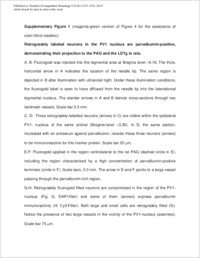Efferent connections of the parvalbumin-positive (PV1) nucleus in the lateral hypothalamus of rodents
- Celio, Marco R. Anatomy Unit, Department of Medicine and Program in Neuroscience, University of Fribourg, Switzerland - Department of Neurology and Program in Neuroscience, Harvard Medical School, Beth Israel Deaconess Medical Center, Boston, USA
- Babalian, Alexandre Anatomy Unit, Department of Medicine and Program in Neuroscience, University of Fribourg, Switzerland
- Ha, Quan Hue Department of Neurology and Program in Neuroscience, Harvard Medical School, Beth Israel Deaconess Medical Center, Boston, USA
- Eichenberger, Simone Anatomy Unit, Department of Medicine and Program in Neuroscience, University of Fribourg, Switzerland
- Clément, Laurence Anatomy Unit, Department of Medicine and Program in Neuroscience, University of Fribourg, Switzerland
- Marti, Christiane Anatomy Unit, Department of Medicine and Program in Neuroscience, University of Fribourg, Switzerland
- Saper, Clifford B. Department of Neurology and Program in Neuroscience, Harvard Medical School, Beth Israel Deaconess Medical Center, Boston, USA
-
2013
Published in:
- Journal of Comparative Neurology. - 2013, vol. 521, no. 14, p. 3133–3153
axonal tracing
Cre dependent viral constructs
periaqueductal gray
ventrolateral column
Su3
PV2
blood pressure
vocalization
REM sleep
adeno associated virus
English
A solitary cluster of parvalbumin-positive neurons – the PV1 nucleus – has been observed in the lateral hypothalamus of rodents. In the present study, we mapped the efferent connections of the PV1 nucleus using nonspecific antero- and retrograde tracers in rats, and chemoselective, Cre-dependent viral constructs in parvalbumin-Cre mice. In both species, the PV1 nucleus was found to project mainly to the periaqueductal grey matter (PAG), predominantly ipsilaterally. Indirectly in rats and directly in mice, a discrete, longitudinally oriented cylindrical column of terminal fields (PV1-CTF) was identified ventrolateral to the aqueduct on the edge of the PAG. The PV1-CTF is particularly dense in the rostral portion, which is located in the supraoculomotor nucleus (Su3). It is spatially interrupted over a short stretch at the level of the trochlear nucleus and abuts caudally on a second parvalbumin-positive (PV2) nucleus. The rostral and the caudal portions of the PV1-CTF consist of axonal endings, which stem from neurons scattered throughout the PV1 nucleus. Topographically, the longitudinal orientation of the PV1-CTF accords with that of the likewise longitudinally oriented functional modules of the PAG, but overlaps none of them. Minor terminal fields were identified in a crescentic column of the lateral PAG, as well as in the Edinger–Westphal, the lateral habenular, and the laterodorsal tegmental nuclei. So far, no obvious functions have been attributed to this small, circumscribed column ventrolateral to the aqueduct, the prime target of the PV1 nucleus.
- Faculty
- Faculté des sciences et de médecine
- Department
- Département de Médecine
- Language
-
- English
- Classification
- Biological sciences
- License
- License undefined
- Identifiers
-
- RERO DOC 118040
- DOI 10.1002/cne.23344
- Persistent URL
- https://folia.unifr.ch/unifr/documents/303033
Other files
Statistics
Document views: 86
File downloads:
- cel_ecp.pdf: 236
- cel_ecp_sm.pdf: 89

